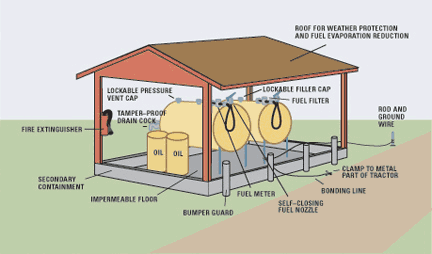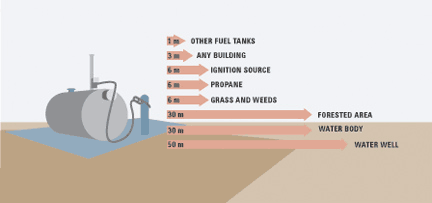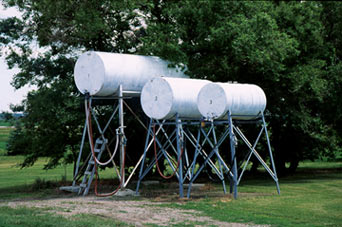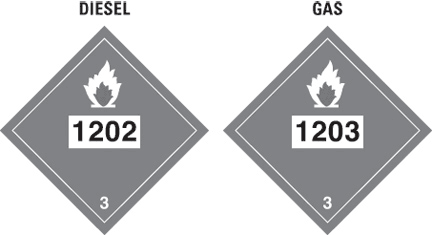| | Siting and setup | Dispensing fuel | Fuel tank safety | Small containers | Monitoring for fuel losses | Transportation of fuel | Legislation | For more information
Diesel, gasoline, lubricants and oils are used extensively on farms today. In Alberta, there are at least 250 million litres of diesel and gasoline storage. Financial (increasing costs), environmental (potential for spills and leaks) and safety (potential fires) concerns are associated with handling and storing fuel on the farm.
At present, the Alberta Fire Code governs the storage and handling of petroleum products. Although Alberta producers are exempt from the Code, its standards are used as guidelines for producers to follow as beneficial management practices.
Siting and Setup
Proper siting and setup of your storage area is important in minimizing or eliminating risks associated with handling fuel (see Figure 6.1). When determining fuel storage locations on your farm, keep minimum separation distances from areas that could be affected by fire and fuel leaks and spills. Prior to installing storage tanks or facilities, ensure equipment such as tanks, support stands and dispensers are in accordance with the Alberta Fire Code.

Figure 6.1. A well planned farm fuel storage site
Courtesy of Resource Management Branch, British Columbia Ministry of Agriculture and Lands. Adapted.
Minimum Separation Distances
Fuel storage areas should be located well away from buildings, trees, ignition sources, other fuel tanks, water bodies and water sources to reduce environmental and safety risks. Keeping the storage area free of vegetation and away from buildings and ignition sources helps reduce the danger to fuel tanks in the event of a fire. Ignition sources include electric motors, road traffic, yard lights, power lines, cell phones, air conditioning or heating units and garbage burning barrels.
The following diagram (Figure 6.2) provides guidelines for distances when siting petroleum storage.

Figure 6.2. Minimum separation distances from fuel storage areas
Stands
Typically, many farm sites in Alberta have gravity-fed tanks on stands 1 to 3 m (4 to 9 ft) high. These tanks tend to become unstable because of the weight of the fuel, or they melt due to a fire, resulting in a spill. The best practice is to mount tanks at ground level, or on solid concrete or steel supports no higher than 0.3 m (1 ft) off the ground. Supports should provide a minimum two-hour fire-resistant rating and be on a firm foundation to help prevent uneven settling.

Aboveground or gravity-fed tanks located too close to trees increase fire hazards and damage from fallen trees
Courtesy of ARD
Secondary Containment
As a safety precaution, secondary containment that contains 110 percent of the maximum volume of the storage tank is recommended. Installing a double-walled tank or using a diking system can accomplish this goal.
Double-walled tanks provide excellent protection against leaks and also provide thermal insulation, reducing extreme changes in fuel temperature. Each double-walled tank has a space between two walls that will contain 10 percent more volume than the storage capacity of the tank.
A dike is an impermeable spill containment area or berm constructed of earth, steel, concrete, solid masonry or synthetic liner that will also hold 110 percent of the tank capacity. If there is more than one tank, then the containment area must hold 110 percent of the largest tank, or the capacity of the largest tank plus 10 percent of the total volume of the remaining tanks, whichever is greater.
Evaporation
Losses due to evaporation vary with the type of storage, fuel and management practices to prevent evaporation. Fuel losses range from minimal in underground tanks, to maximal in poorly located or maintained overhead tanks. The heating of aboveground tanks from the sun causes the fuel to evaporate (volatilize) into the atmosphere. The more the fuel temperature changes, the greater the potential for fuel losses and risk of contamination due to condensation. Evaporation losses are greater for gasoline than diesel because gasoline is more volatile. For estimations of evaporative losses due to different tank conditions in summer months for aboveground storage, refer to Table 6.1.
Table 6.1. Evaporative losses from a 1,200 litre (265 gallons) aboveground gasoline storage tank
| Tank conditions |  |  | Evaporation lost per summer months |  | % of full tank lost |
 |  |  | Litres | Gallons | % |
| Dark tank | in sun |  | 38 | 8.4 | 3.2 |
| White tank | in sun |  | 23 | 5.1 | 1.9 |
| Dark tank | in sun | with pressure vent cap | 21 | 4.6 | 1.8 |
| White tank | in sun | with pressure vent cap | 9 | 2 | 0.8 |
| Dark tank | in shade |  | 9 | 2 | 0.8 |
| White tank | in shade | with pressure vent cap | 5 | 1.1 | 0.4 |
| For comparison purposes: |
| Underground tank |  | < 4 | < 1 | 0.3 |
| Double-walled aboveground tank |  | Losses similar to underground tank |  |
| Source: Farm Storage and Handling of Petroleum Products, Farm Mechanization Factsheet No. 210.510-1, Resource Management Branch, British Columbia Ministry of Agriculture and Lands. |
The following steps reduce fuel evaporation losses:
- Paint the tank with reflective paint (silver or white) and reduce evaporation losses by up to 40 percent compared to a dark-coloured tank.
- Use a pressure ventilated cap to reduce evaporation losses by 50 percent. This type of cap restricts direct venting of tank fumes until a slight pressure has built up in the tank. Having a painted and pressure-vented tank has a 75 percent evaporation loss reduction compared to a dark-coloured tank.
- Locate a painted and pressure-vented tank in the shade to further reduce evaporation losses by over 40 percent. A shelter with a roof also helps reduce weathering of hoses and valves (see Figure 6.1).
- Do not fill the tank to more than 90 percent of its capacity; this practice reduces pressure in the tank, and thus, evaporative or spill losses.
Dispensing Fuel
Care and caution should be taken while fuelling vehicles, farm machinery or jerry cans.
To reduce spills and avoid fires, use the following procedures when dispensing fuels:
Ensure the dispenser unit is ULC and CSA approved, with automatic shut-off valves.
- Use a hand or electric pump. If using an electric pump, it must be installed according to the Code of Electrical Installations at Oil and Gas Facilities.
- Close the valves on tank discharges when they are not in use to prevent leakage through the hose or nozzle.
- Never leave the area unattended even if automatic shut-off nozzles are being used. There is always the possibility of nozzles malfunctioning or getting knocked out of the tank.
Fuel Tank Safety
To prevent further fuel losses from occurring, you need to regularly maintain and monitor storage facilities by taking the following additional precautions:
- Protect tanks and piping against corrosion to prevent leaks.
- Protect all pumps, lines and tanks from collision damage by installing bollards (barriers constructed of a sturdy material, such as steel piping filled with cement, set up close to fuel tanks to guard against collision damage).
- Make sure fill-up hoses are long enough, so vehicles and farm equipment can be kept at a safe distance from the tanks.
- Keep fuel lines, hoses, valves and nozzles in good repair. Install anti-siphon valves between the pump and tank to prevent the tank from draining if the line breaks.
- Lock all fuel tanks when not in use to reduce the risk of spills caused by vandalism or theft.
- Ground the pumps and vehicles to avoid build up of static electricity, explosions and fires. Attach a bonding line to the vehicle prior to filling it from an aboveground fuel storage tank to reduce the risk of static electricity igniting fuel vapours (see Figure 6.1).
Just in case of fire...
To effectively fight a fire, first you need to know what type of fire you are dealing with:
Class A – involves ordinary combustibles such as wood, paper, cloth, plastic, etc.
Class B – involves flammable and combustible liquids such as grease, gas, oils, paints, etc.
Class C – involves electrical equipment such as appliances, computers, breakers, motors, switches, etc.
Class D – involves burning metals such as aluminum, magnesium, sodium, etc.
Each type of fire requires a different type of fire extinguisher:
Pressurized Water – used for Class A fires, but not for Class B, C and D fires
Dry Chemical – used for Class ABC fires. These include Type ABC and Type BC fire extinguishers.
Carbon Dioxide (CO2) – used for Class B and C fires, but not for class A and D fires. These extinguishers do not leave harmful residues behind like dry chemical extinguishers.
Metal or Sand – used for Class D fires, but not Class ABC fires. The most common extinguishing agent in this class is sodium chloride, but there are a variety of other options.
Fire extinguishers should be accessible in the case of an emergency and should be checked and maintained on a regular basis. When storing and handling fuel on your farm, ensure a dry chemical such as a 40 pound Type BC or carbon dioxide fire extinguisher is located close enough to the fuel storage site, yet far enough away that the intensity of a fire would not stop you from getting it if necessary.
Small Containers
Precautions during storage and filling of small containers, such as jerry cans, need to be considered. Small containers should be stored away from direct sunlight and supported in an upright position. They should not be stored in or near living quarters such as basements.
To avoid mixing fuels, place different fuels in different coloured jerry cans. As a general rule of thumb, a gasoline jerry can is red, diesel is yellow and kerosene is blue.
To prevent spills when pouring from a jerry can, use funnels, spill-proof or stop-flow spouts or nozzles. Hand pumps are also available to eliminate or reduce spills and leaks.
Monitoring for Fuel Losses
To avoid spills and catch leaks, it is recommended that fuel tanks be monitored at least every 2 weeks. The best way to determine if there is a leak is through a visual inspection when walking around the tank, looking for rust spots, stains on the ground or cracks, breaks or bends in the hose.
Another way to determine if fuel losses are occurring is to maintain inventory records. An example of a fuel inventory control sheet is included in Figure 6.3. If the tank is equipped with a meter, an ongoing inventory record, kept for a minimum of two years or as long as the life of the tank, should be updated when fuel is used and added to the tank. The expected volume is compared to the actual volume. This amount is obtained from fuel dipping, which is measuring the amount of fuel in a tank with a dipstick or tape. Do not dip tanks immediately after fuel delivery; allow time for fuel agitation to subside.
If the tank size is unknown and is not equipped with a meter, it may not be possible to maintain an ongoing inventory record. Allow the tank to sit unused for 24 hours and measure the level of fuel at the start and end of the 24-hour period. Compare the measurements for signs of fuel loss. These measurements will be more consistent if done at least 24 hours after fuel delivery.
Any trend of unexplained losses of fuel or increases may indicate a leak and should be investigated further. You can also verify that a leak is occurring by using water-sensitive paste on the tip of the stick. If water can get into the tank, fuel can get out of the tank.
Despite taking necessary precautions to prevent spills and leaks, they do occur and must be dealt with effectively and efficiently. If a spill does occur, stop the flow as quickly as possible to prevent fuel from entering water bodies or sources and catching fire. Fuel can ignite easily when it overflows a vehicle’s tank and comes in contact with a hot exhaust system. Use non-combustible materials such as soil to contain the spill; never use rags or sawdust to absorb it as these materials can easily catch fire. Contact your local fire department if the spill is more than 50 litres (13 gallons). If the spill is greater than 200 litres (53 gallons), as a regulatory requirement, you must report it to Alberta Environment by contacting their emergency department. (For contact information, refer to For More Information at the end of this chapter.)
| Fuel Inventory |  |  |  |  |
| Sample Fuel Inventory Control Sheet |
| Tank 1 |  |  |  |  |
| Fuel Type |  |  |  |  |
| Fuel Dips (cm) |  | 97 |  | This value is determined by dipping your tanks with a measuring rod or tape. The measurement is taken in centimeters. |
| Actual Volume (L) |  | 2,054 |  | This value is determined from the chart supplied by tank manufacturers. A depth of 97 centimeters converts to a volume of 2,054 litres (for this example). |
| Previous Actual Volume |  | 1,710 |  | Obtained from actual volume figures on your last inventory sheet. |
| Deliveries | + | 500 |  | Fuel delivered since last inventory sheet. |
| Present Volume | = | 2,210 |  | Previous actual volume plus deliveries. |
| Usage | – | 162 |  | Fuel removed from the tanks since last inventory sheet. |
| Expected Inventory | = | 2,048 |  | The amount of fuel you expect to be in your tank (present volume minus usage). |
| Actual Volume (from dips) |  | 2,054 |  | Actual fuel in the tank as calculated from fuel dip. |
| Expected Inventory | – | 2,048 |  | This figure is the expected inventory as calculated above. |
| Today’s Variance* | = | 6 |  | The difference between actual volume and expected inventory. |
| Previous YTD Variance* | + | -52 |  | Cumulative year-to-date (YTD) variance from the last inventory sheet. |
| YTD Variance* | = | -46 |  | Current YTD variance. |
| Water Reading (cm) | = | 0.5 |  | The water reading in the tank using water-sensitive paste on the dipstick. |
*A negative variance indicates a fuel shortage.
Transportation of Fuel
The Transportation of Dangerous Goods Regulations regulates the transporting of fuel on Alberta highways.
When transporting fuel in volumes less than 450 litres (combined capacity of all containers), diesel is unregulated. The diesel tank requires only a flammable placard or sticker. A gasoline tank is regulated, and therefore a placard with the UN number, shipping name and label are required.
When transporting more than 450 litres and less than 2,000 litres (combined capacity of all containers) of gasoline or diesel, the tank requires one flammable liquid placard attached to the tank. The UN number for diesel and gasoline are 1202 and 1203 respectively (see Figure 6.4).

Figure 6.4. Placards showing flammable symbol, class and UN number
Legislation
Producers should be aware of the following pieces of legislation that pertain to petroleum storage and handling and the potential environmental risks. For more information on the legislation, refer to Chapter 12 of this manual.
Federal Legislation
Transportation of Dangerous Goods Act
Transportation of Dangerous Goods Regulations
Provincial Legislation
Environmental Protection and Enhancement Act
For More Information
All Alberta government offices may be reached toll-free by dialing the Rite Line: 310-0000
Alberta Agriculture and Rural Development
Ag-Info Centre: 310-FARM (3276)Website: www.agric.gov.ab.ca
Alberta Environment
General Inquiries: 780-427-2700
Report spills or releases to the Alberta Environment Response Centre 24-hour-toll free line: 1-800-222-6514
Website: http://aep.alberta.ca
Alberta Municipal Affairs
Safety Services: 1-866-421-6929
Alberta Fire Code
Website: www.municipalaffairs.gov.ab.ca
Alberta Transportation
Dangerous Goods and Rail Safety Branch: 1-800-272-9600
Dangerous Goods and the Agricultural Industry
Website: www.trans.gov.ab.ca
Safety Codes Council
General Inquiries: 1-888-413-0099
Website: www.safetycodes.ab.ca
Canadian Standards Association (CSA)
General Inquiries: 1-800-463-6727
Canadian Electrical Code, Part I (20th Edition), Safety Standard for Electrical Installations
Website: www.csa.ca
Canadian Farm Business Management Council
Publications: 1-888-232-3262
Planning for and Responding to Disasters in Canada
Website: www.farmcentre.com
Petroleum Tank Management Association of Alberta
General Inquiries: 1-866-222-8265
Farm Tank Brochure
Website: www.ptmaa.ab.ca |
|